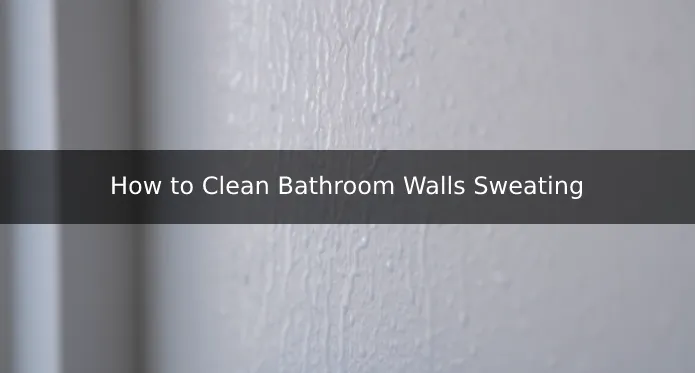Last Updated on March 6, 2023
Sweating walls in the bathroom can be a massive source of frustration, especially when trying to keep your shower space looking and smelling fresh. No matter how often you clean, the moisture accumulating on the bathroom walls can quickly become a breeding ground for bacteria or mildew.
Sweating can cause permanent damage and discoloration to the bathroom walls if not treated in time. With a multi-surface cleaner, a stiff brush, and following a few simple steps, you can achieve refreshingly clean bathroom walls without having to strain yourself.
Throughout this article, we’ll walk you through cleaning the bathroom walls sweating. Also, answer some of your common questions about why bathroom walls sweat in the first place and how to prevent future moisture build-ups.
How to Clean Bathroom Walls Sweating: 6 Steps

Sweat deposits can accumulate on walls over time, causing surfaces to appear dull and grimy. So, cleaning bathroom walls sweat is essential to keeping a home healthy and looking great. To make sure you’re doing it right, here are six steps:
STEP 1. Prepare Cleaning Materials and Tools
Before beginning the cleaning process, gathering the necessary materials and tools for the job is essential. First, collect a bucket, water, and a cleaning solution. Depending on how hard your walls are sweating, you may need to mix a stronger formula than typical household cleaners.
You may also want to grab some cleaning sponges or cloths, scrub brushes, rubber gloves, a step ladder or stool if necessary for reaching higher spots on the wall, and a ventilation fan or open window to help keep the air moving in the bathroom during and after cleaning.
STEP 2. Mix the Cleaning Solution
Once you have collected all of the necessary supplies, it’s time to mix up your cleaning solution. If you purchased premade products, simply follow their packaging instructions to create an appropriate mixture.
When mixing your solution, combine equal parts water and white vinegar with a few drops of liquid dish soap into a bucket until blended evenly. The amount of liquid used should depend on how large an area needs to be cleaned, so adjust accordingly before moving on to the next step.
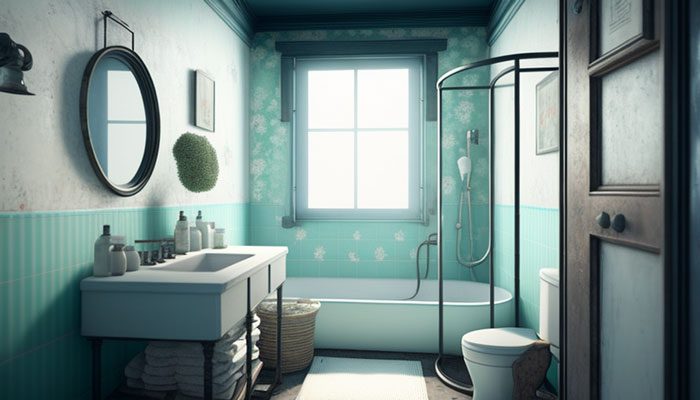
STEP 3. Begin Cleaning Process
Begin by thoroughly wetting your walls with warm water using a sponge or cloth until they’re entirely damp but not dripping wet. Once complete, dip your sponge into the cleaning solution mix and apply directly onto the affected areas in circular motions from top to bottom of each wall.
To avoid making your cleaning job harder, work from the top down. This way, the dirt particles you remove won’t slide down and create streaks or smears on lower surfaces.
STEP 4. Scrub Away Sweat Deposits
Using a stiff brush or sponge, start scrubbing away at sweat deposits found within corners and crevices first. Ensure to notice all hidden spots, as these can be more tricky later when dry again if overlooked during the wet stage.
After completing this task rinse walls off one more time with fresh, clean, warm water ensuring all soap suds are gone, and no residue remains behind. Otherwise, walls will become sticky when drying out again afterward.
STEP 5. Wipe Down With Damp Cloths

Now that the sweat deposits have been removed and the walls are free of soap suds, it’s time to wipe them down with damp cloth. To do this, gently wipe the surface of your bathroom walls in a circular motion to remove any sweat or grime that may have accumulated over time.
STEP 6. Allow Walls to Air Dry Completely
Finally, allow the bathroom walls to air dry completely before continuing your cleaning routine. If possible, open a window or switch on a fan to speed up the drying process and eliminate lingering moisture between painted wall tiles or tight crevices.
Once your bathroom walls are dry to the touch, you can rest assured knowing that you’ve achieved refreshingly clean bathroom walls ready for use.
Why Do Bathroom Walls Sweat After the shower?
After long and hot showers, many people experience sweat on their bathroom walls. Several factors, such as:
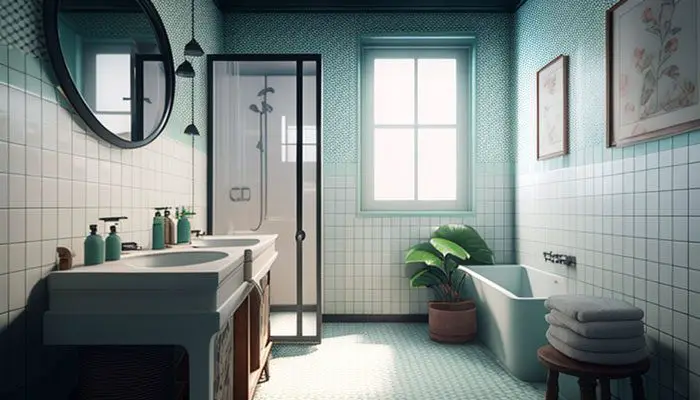
A. Condensation
Condensation occurs when warm, wet air hits a cool surface like a wall or window in the bathroom. When this happens, droplets of water form on the surface of the wall and cause it to become damp or even wet after a shower.
To prevent bathroom condensation on bathroom walls, you must keep the room well-ventilated with fresh air to reduce humidity levels and maintain an appropriate temperature difference between the room and the bathroom wall surfaces.
Also, using fans during long showers can help remove excess moisture from the air and reduce condensation buildup on walls.
B. Poor Ventilation
Poor ventilation can be a major factor in why bathroom walls may sweat after a hot shower. Without proper airflow in a closed space like a bathroom, humid air will build up quickly with no way to escape from the room.
As warmer moisture builds up in the air with no place to go, it will eventually reach its dew point and start condensing onto cooler surfaces like walls and windows, which can lead to excessive sweating on these surfaces after a shower.
To combat poor ventilation in bathrooms, homeowners should ensure that vents are open or that windows are cracked slightly during and after hot showers for better airflow within these spaces.
C. Inadequate Insulation
Inadequate insulation can also be responsible for causing bathroom walls to sweat after taking a shower if there is not enough material between the interior wall of your home and the exterior wall facing outwards towards extreme temperatures outside your house.
This gap allows warm moist air from inside your home to hit cold outdoor temperatures, which will cause sweating on both sides of exterior-facing walls once again due to condensation forming on cooler surfaces when warm moisture meets them head-on.
To fix this issue, homeowners should adequately insulate any gaps between interior and exterior facing bathroom walls and ensure that all other external walls are properly insulated so they do not absorb heat from outside sources.
D. Structural Defects
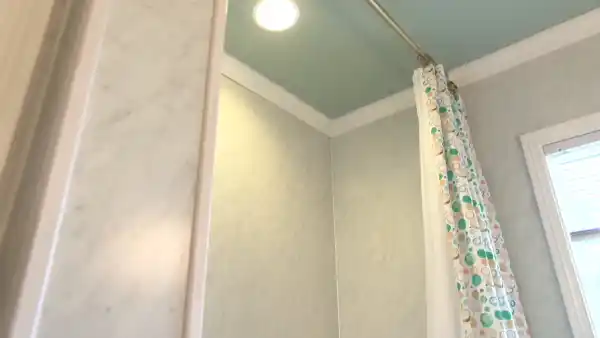
Bathroom walls can sweat after a shower due to structural defects in the building materials or construction of the wall. Poor construction practices, such as insufficient insulation, air circulation, and an impenetrable outer wall, can cause moisture levels and condensation.
Furthermore, improperly sealed windows and doors can lead to warm, humid air leaking into the bathroom space, further increasing humidity levels. This can cause water droplets to collect on the bathroom walls and ceilings due to condensation, resulting in “sweating” walls.
E. Excessive Water Vapor
Excess water vapor in a bathroom after a hot shower is one of the main causes of bathroom walls sweating afterward. During a hot shower, the moist air produced by steam quickly rises and combines with existing warm air already in the room.
As this humid air cools down, it deposits its moisture onto colder surfaces like windows or even walls which can then cause them to sweat afterward. Using a bathroom ventilation fan while taking a shower can reduce the amount of water vapor.
F. Poor Construction Materials
Poor construction materials used on bathroom walls are another factor that might cause them to sweat after showers have been taken in them. If your bathroom walls are made from cheap materials like drywall or laminates, they might not be able to protect your bathroom against high humidity levels and water vapor.
To combat this, choosing better quality waterproofing products when constructing bathroom walls is advised as they will be better equipped to keep out excess moisture; otherwise, it could result in increased sweating afterward.
Why Do Bathroom Walls Always Look Wet?
Bathroom walls always look wet because of condensation due to high humidity levels in a closed space. Condensation happens when warm moist air touches cold surfaces such as window panes, pipes, or walls resulting in droplets forming on these surfaces.

High humidity inside bathrooms often occurs due to inadequate ventilation. If the bathroom does not have proper airflow, warm air gets trapped within and contacts cold surfaces creating condensation on its outer surface, thus giving it a wet look.
Is it Normal for Bathroom Walls to Sweat?
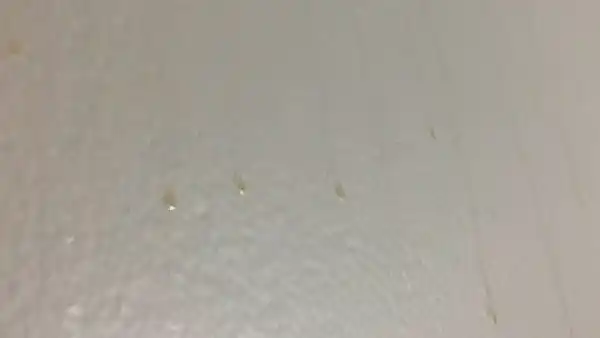
You should expect bathroom walls to sweat because many bathrooms will experience high humidity levels due to poor ventilation or other factors, such as lack of insulation which increases the temperature within the room.
This results in increased moisture levels in the air for condensation to form on cold surfaces such as walls and windows, which makes them feel damp and even wet. It is essential to have good ventilation in bathrooms. This will allow moisture to escape and prevent damage or discomfort to people in the house.
Can Moisture in Bathroom Walls be Fixed After Sweating?
Moisture in bathroom walls can be fixed after sweating. When moisture accumulates in your bathroom walls, you can make those damp walls dry again.
All you need to do is inspect the walls for signs of water damage and find out the source of the moisture. Then, reduce humidity levels with a dehumidifier so that your walls can dry out completely before painting or resurfacing them.
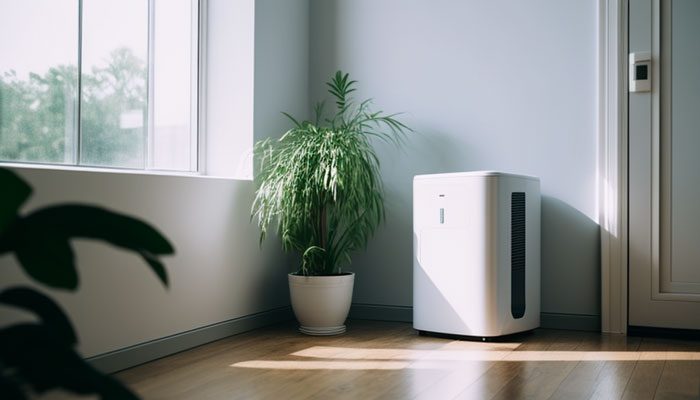
It’s important to have a properly functioning ventilation system as well. Ensure all exhaust vents are open, so your bathroom is ventilated correctly. With some proactive steps in place, you’ll be able to resolve your bathroom moisture problems in no time.
What is the Yellow Stuff that Drips on Bathroom Walls After Sweat?
If you see yellow stuff on your bathroom walls after sweating, it’s mildew. It is a fungus, usually forming an easily recognizable yellow or black stain on surfaces such as bathroom walls.
With ideal conditions and warm humidity, mildew can develop within 24 hours and can even lead to permanent damage if left untreated. Usually manifesting as yellow, green, or brown spots, this pervasive infestation should be taken seriously and treated quickly with suitable cleaning products and prevention methods.
How to Stop Bathroom Walls From Sweating in the Future?
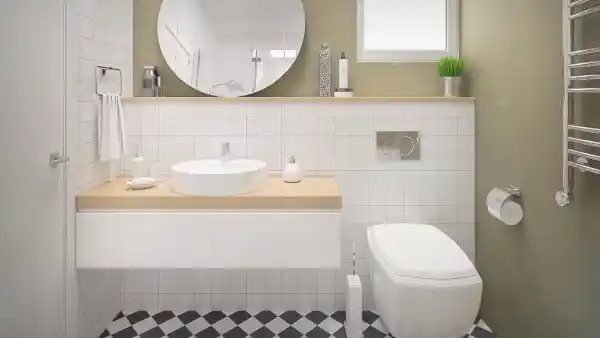
To prevent bathroom walls from getting sweaty later, you must improve air circulation and ventilation in this area. You can prevent mildew growth by opening doors and windows when bathing and showering and choosing water-resistant wall surfaces that drain away condensation quickly.
Also, using an exhaust fan during showers will ensure moist air is drawn out of the room. Regularly wiping down surfaces with a cloth or towel will also help absorb moisture from the air before it can cause damage.
Sparkle Your Bathroom Walls With 6 Gleamingly Clean Steps
Sweaty and stained bathroom walls can be an eyesore that nobody wants to deal with. Fortunately, following the above six easy steps will soon have sparkling clean walls without any traces of dirt or grime residue.
But remember, you need to understand why your walls sweat and what could be done to prevent it in the future. Keep up with regular maintenance and ensure you use appropriate cleaning supplies for stubborn residue.
After reading this article, we hope you learn how to clean bathroom walls that are sweating and why they sweat in the first place.

